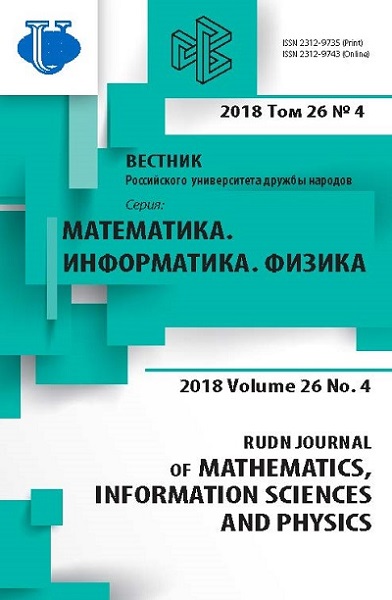On Normal Modes of the Closed Waveguide with Discontinuous Filling
- Authors: Malykh M.D1
-
Affiliations:
- Peoples’ Friendship University of Russia (RUDN University)
- Issue: Vol 26, No 4 (2018)
- Pages: 321-330
- Section: Mathematical Modeling
- URL: https://journals.rudn.ru/miph/article/view/20222
- DOI: https://doi.org/10.22363/2312-9735-2018-26-4-321-330
Cite item
Full Text
Abstract
We consider a waveguide of a constant cross-section S with ideally conducting walls. We assume that the filling of waveguide doesn’tchange along its axis and is described by the piecewise continuous functions ε and μ defined on waveguide cross-section. We show that it is possible to make substitutionwhich allows to work only with continuous functions.
Instead of noncontinuous cross-components of an electromagnetic field E and H we offer to use four potentials ue,uh and ve,vh. We can prove as the generalization of Tikhonov—Samarskii theorem that any field in the waveguide allows representation in such form if we consider the potentials ue,uh as elements of Sobolev space Wo21(S) and the potentials ve,vh as elements of Sobolev space W21(S).
If ϵ and m are the piecewise constant functions then Maxwell’s equations written in four potentialsreduce to a pair of independent systems. This statement give us new approach to theinvestigation of spectral properties of waveguides. First, we can prove the completenessof the system of the normal waves in closed waveguides using standard functionalspaces. Secondly, we can offer new technique for calculation of the normal waves usingstandard finite elements. FreeFem++ program for calculation of disperse lines ofwaveguides is presented. The question of calculation of modes at great values of k=ω/c is also considered.
About the authors
Mikhail D Malykh
Peoples’ Friendship University of Russia (RUDN University)
Author for correspondence.
Email: malykh-md@rudn.ru
Candidate of Physical and Mathematical Sciences, assistant professor of Department of Applied Probability and Informatics of Peoples’ Friendship University of Russia (RUDN University)
6, Miklukho-Maklaya str., Moscow, 117198, Russian FederationReferences
- A. A. Samarskiy, A. N. Tikhonov, On the Representation of a Field in a Waveguide in the Form of a Sum of Fields TE and TM, Technical Physics. The Russian Journal of Applied Physics [Zhurnal tekhnicheskoy fiziki] 18 (7) (1948) 959–970, in Russian.
- K. Zhang, D. Li, Electromagnetic Theory for Microwaves and Optoelectronics. 2nd ed., Springer, Berlin, 2008.
- I. E. Mogilevskii, A. G. Sveshnikov, Mathematical Problems of the Theory of Diffraction, Faculty of Physics MSU, Moscow, 2010, in Russian.
- A. N. Bogolyubov, A. L. Delicyn, A. G. Sveshnikov, On the problem of the Excitation of a Waveguide with an Inhomogeneous Medium, Computational Mathematics and Mathematical Physics 38 (11) (1999) 1815–1823.
- A. L. Delicyn, On One Approach to the Question of the Completeness of Normal Waves of a Waveguide with a Magnetodielectric Filling, Differentsialnye Uravneniya 36 (5) (2000) 629–633, in Russian.
- A. N. Bogolyubov, A. L. Delicyn, M. D. Malykh, On the Root Vectors of a Cylindrical Waveguide, Computational Mathematics and Mathematical Physics 41 (1) (2001) 121–124, in Russian.
- A. L. Delicyn, On the Completeness of the System of Eigenvectors of Electromagnetic Waveguides, Computational Mathematics and Mathematical Physics 51 (10) (2011) 1771–1776.
- A. L. Delicyn, Application of the Finite Element Method to the Calculation of Modes of Dielectric Waveguides, Computational Mathematics and Mathematical Physics 39 (2) (1999) 298–304, in Russian.
- A. L. Delicyn, S. I. Kruglov, Application of a Method of the Mixed Finite Elements for Calculation of Modes of Cylindrical Waveguides with Variable Index of Refraction, Journal of radio electronics (4), in Russian.
- E. Lezar, D. B. Davidson, Electromagnetic Waveguide Analysis, in: Automated solution of differential equations by the finite element method, The FEniCS Project, 2011, pp. 629–643, in Russian.
- V. C. Coffey, Novel Fibers Use Space to Extend Capacity Limits, Photonics Spectra 4 (7), in Russian.
- D. V. Divakov, M. D. Malykh, A. L. Sevastianov, L. A. Sevastianov, Simulation of Polarized Light Propagation in the Thin-Film Waveguide Lens, RUDN Journal of Mathematics, Information Sciences and Physics 25 (1) (2017) 56–68, in Russian.
- M. D. Malykh, L. A. Sevastianov, A. A. Tiutiunnik, N. E. Nikolaev, On the Representation of Electromagnetic Fields in Closed Waveguides Using Four Scalar Potentials, Journal of Electromagnetic Waves and Applications 32 (7) (2018) 886–898.
- M. D. Malykh, A. L. Sevastianov, L. A. Sevastianov, A. A. Tyutyunnik, On the Reduction of Maxwell’s Equations in Waveguidesto the System of Coupled Helmholtz Equations, RUDN Journal of Mathematics, Information Sciences and Physics 26 (1) (2018) 39–48, in Russian.
- A. A. Tyutyunnik, On the Calculation of Electromagnetic Fields in Closed Waveguides with Inhomogeneous Filling, RUDN Journal of Mathematics, Information Sciences and Physics 26 (2) (2018) 129–139, in Russian.
- F. Hecht, New Development in FreeFem++, J. Numer. Math. 20 (3–4) (2012) 251–265.
- J. Love, Theory of Elasticity, GTTI, 1939, in Russian.
- G. Duvaut, J.-L. Lions, Les in´equations en m´ecanique et en physique, Dunod, Paris, 1972.
- F. Stummel, Randund Eigenwertaufgaben in Sobolewschen R¨aumen, Springer, Berlin-Heidelberg-New York, 1969.
- W. C. Chew, Lectures on Theory of Microwave and Optical Waveguides (2012). URL http://wcchew.ece.illinois.edu/chew/course/tgwAll20121211.pdf
- V. M. Babich, V. S. Buldyrev, Short-Wavelength Diffraction Theory: Asymptotic Methods, Springer, Berlin, 1991.
















